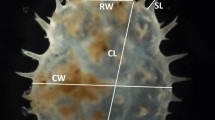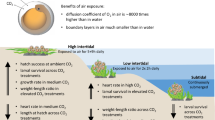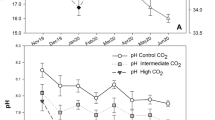Abstract
It widely thought that ocean acidification processes that caused by atmospheric CO2 increase and accordingly lower seawater pH conditions might cause serious harm to marine food webs in certain ecosystems in the near future. Little is known about how marine fishes respond to reduced pH conditions. We investigated the effects of CO2 conditions on the growth of olive flounder (Paralichthys olivaceus) larvae. Newly hatched larvae were reared at three different levels of pCO2 (574, 988 and 1297 µatm) in temperature-controlled (21 ± 0.5°C) water tanks for four weeks until metamorphosis. The experiment was repeated three times in May, June, and July 2011, and body lengths and weights were measured at the completion of each experiment. The results indicated that the body length and weight of flounder larvae significantly increased with increasing CO2 concentrations (P < 0.05). A higher daily growth rate during the early larval stage (hatching to 14 days) was found among the larvae reared in low pCO2 conditions, while a significantly lower growth rate was found among larvae in higher pCO2 water conditions. On the other hand, in the late larval stage (18 days after hatching to metamorphosis), the daily growth rate of larvae was much higher in high CO2 water. Bone density of larvae, however, decreased with increasing CO2 concentration in the water
Similar content being viewed by others
References
Baumann H, Talmage SC, Gobler CJ (2012) Reduced early life growth and survival in a fish in direct response to increased carbon dioxide. Nat Clim Change 2:38–41
Boyde A (1972) Biological specimen preparation for the scanning electron microscope — an overview. In: Johari O, Covin I (eds) Scanning electron microscopy 1972. Part II. IITRI, pp 257–264
Brown DJA, Sadler K (1989) Fish survival in acid waters. In: Morris R, Taylor EW, Brown DJA, Brown JA (eds) Acid toxicity and aquatic animals. Cambridge University Press, Cambridge, UK, pp 31–44
Checkley Jr. DM, Dickson AG, Takahashi M, Radich JA, Eisenkolb N, Asch R (2009) Elevated CO2 Enhances Otolith Growth in Young Fish. Science 324:1683
Dickson AG, Millero FJ (1987) A comparison of the equilibrium constants for the dissociation of carbonic acid in seawater media. Deep-Sea Res 34:1733–1743
Dickson AG, Sabine CL, Christina JR (2007) Guide to best practices for ocean CO2 measurements. North Pacific Marine Science Organization, Sidney, PICES Special Publication 3, 191 p
Dixson DL, Munday PL, Jones GP (2010) Ocean acidification disrupts the innate ability of fish to detect predator olfactory cues. Ecol Lett 13:68–75
Feely RA, Sabine CL, Lee K, Berelson W, Kleypas J, Fabry VJ, Millero FJ (2004) Impact of anthropogenic CO2 on the CaCO3 system in the oceans. Science 305:362–366
Feely RA, Doney SC, Cooley SR (2009) Ocean acidification: present conditions and future changes in a high-CO2 world. Oceanography 22(22):36–47
Frommel AY, Maneja R, Lowe D, Malzahn AM, Geffen AJ, Folkvord A, Piatkowski U, Reusch TBH, Clemmesen C (2012) Severe tissue damage in Atlantic cod larvae under increasing ocean acidification. Nat Clim Change 2:42–46
Gattuso J-P, Hansson L (2011) Ocean acidification: background and history. In: Gattuso J-P, Hansson L (eds) Ocean acidification. New York, pp 1–20
Gazeau F, Gattuso J-P, Dawber C, Pronker AE, Peene F, Peene J, Heip CHR, MiddelburgJJ (2010) Effect of ocean acidification on the early life stages of the blue mussel, Mytilus edulis. Biogeosciences 7:2051–2060
Green BS, Fisher R (2004) Temperature influences swimming speed, growth and larval duration incoral reef fish larvae. J Exp Mar Biol Ecol 299:115–132
Hoegh-Guldberg O, Mumby PJ, Hooten AJ, Steneck RS, Greenfield P, Gomez E, Harvell CD, Sale PF, Edwards AJ, Caldeira K, KnowltonN, EakinCM, Iglesias-Prieto R, Muthiga N, Bradbury RH, Dubi A, Hatziolos ME (2007) Coral reefs under rapid climate change and ocean acidification. Science 318(5857):1737–1742
Hoegh-Guldberg O, Bruno JF (2010) The impact of climate change on the world’s marine ecosystems. Science 328(5985):1523–1528
Hurst TP, Fernandez ER, Mathis JT (2013) Effects of ocean acidification on hatch size and larval growth of walleye pollock Theragra chalcogramma. ICES J Mar Sci 70(70):812–822
Ishimatsu A, Hayashi M, Kikkawa T (2008) Fishes in high-CO2, acidified oceans. Mar Ecol-Prog Ser 373:295–302
Ju SJ, Kim SJ (2013) Assessment of the impact of climate change on marine ecosystem in the South Sea of Korea II. Ocean Polar Res 35(35):123–125
Kawashima S, Hama T, Satoh Y, Shimotori K, Omori Y, Adachi T, Hasegawa S, Endoh H, Nakayama T, Inoue I, Midorikawa T, Ishii M, Saitoh S, Sasano D (2012) Experimental study on the effect of acidification of seawater on structure of coastal phytoplankton population. In: AGU Ocean Sciences Meeting, 22–26 Feb 2012
Kikkawa T, Ishimatsu A, Kita J (2003) Acute CO2 tolerance during the early developmental stages of four marine teleosts. Environ Toxicol 18:375–382
Kleypas JA, Feely RA, Fabry VJ, Langdon C, Sabine CL, Robbins LL (2006) Impacts of ocean acidification on coral reefs and other marine calcifiers: a guide for future research. Report of a workshop sponsored by NSF, NOAA, and the U.S. Geological Survey, St. Petersburg, Florida, 88 p
KOSIS (2012) Aquaculture Status Statistics. Korea Statistical Information Service, http://www.kosis.kr/ Accessed 30 July 2012
Kurihara H, Shimode S, Shirayama Y (2004) Effects of raised CO2 concentration on the eggproduction rate and early development of two marine copepods (Acartia steueri and Acartia erythraea). Mar Pollut Bull 49:721–727
Meehl GA, Stocker TF (2007) Global climate projections. In: Solomon S, Qin D, Manning M, Chen Z, Marquis M, Averyt KB, Tignor M, Miller HL (eds) Climate change 2007: the physical science basis. Cambridge University Press, Cambridge, UK, pp 686–688
Meekan MG, Carleton JH, McKinnon AD, Flynn K, Furnas M (2003) What determines the growth of tropical reef fish larvae in the plankton: food or temperature? Mar Ecol-Prog Ser 256:193–204
Mehrbach C, Culberson CH, Hawley JE, Pytkowicz RM (1973) Measurement of the apparent dissociation constants of carbonic acid in seawater at atmospheric pressure. Limnol Oceanogr 18:897–907
Michaelidis B, Ouzounis C, Paleras A, Pörtner HO (2005) Effects of long-term moderate hypercapnia on acid-base balance and growth rate in marine mussels Mytilus galloprovincialis. Mar Ecol-Prog Ser 293:109–118
Michaelidis B, Spring A, Pörtner HO (2007) Effects of long-term acclimation to environmental hypercapnia on extracellular acid-base status and metabolic capacity in Mediterranean fish, Sparus aurata. Mar Biol 150:1417–1429
Miles H, Widdicombe S, Spicer JI, Hall-Spencer J (2007) Effects of anthropogenic seawater acidification on acid-base balance in the sea urchin, Psammechinus miliaris. Mar Pollut Bull 54:89–96
Morgan IJ, McDonald DG, Wood CM (2001) The cost of living for freshwater fish in a warmer, more polluted world. Glob Change Biol 7:345–355. doi:10.1046/j.1365-2486.2001.00424.x
Munday PL, Donelson JM, Dixson DL, Endo GGK (2009) Effects of ocean acidification on the early life history of a tropical marine fish. Proc R Soc B 276:3275–3283
NFRDI (National Fisheries Research and Development Institute) (2010) Ecology and Fishing Ground. Yemun, Busan, 405 p
NFRDI (National Fisheries Research and Development Institute) (2006) Standard manual of olive flounder culture. Haein, Busan, 215 p
Orr JC, Fabry VJ, Olivier A, Bopp L, Doney SC, Feely RA, Gnanadesikan A, Gruber N, Ishida A, Joos F, Key RM, Lindsay K, Maier-Reimer E, Matear R, Monfray P, Mouchet A, Najjar RG, Plattner GK, Rodgers KB, Sabine CL, Sarmiento JL, Schliter R, Slater RD, Totterdell IJ, Weirig MF, Yamanaka Y, Yool A (2005) Anthropogenic ocean acidification over the twenty-first century and its impact on calcifying organisms. Nature 437:681–686
Pierrot DEL, Wallace DWR (2006) MS Excel program developed for CO2 System Calculations. ORNL/CDIAC-105, Oak Ridge, Tennessee, CarbonDioxide Information Analysis Center, Oak Ridge National Laboratory, US Department of Energy
Pörtner HO, Langenbuch M, Reipschlager A (2004) Biological impact of elevated ocean CO2 concentrations: lessons from animal physiology and earth history. J Oceanogr 60:705–718
Pörtner HO, Langenbuch M, Michaelidis B (2005) Synergistic effects of temperature extremes, hypoxia, and increases in CO2 on marine animals: from earth history to global change. J Geophys Res-Oceans 110:C09S10. doi: 10.1029/2004JC002561
Ries JB, Cohen AL, McCorkle DC (2009) Marine calcifiers exhibit mixed responses to CO2-induced ocean acidification. Geology 37:1131–1134
Searcy S, Sponaugle S (2000) Variable larval growth in a coral reef fish. Mar Ecol-Prog Ser 206:213–226
Shim JH, Kim KS, Kim S (2013) The effects of elevated carbon dioxide in seawater on the early life stages of black sea bream Acanthopagrus schlegelii. Korean J Fish Aquat Sci 46(46):862–867
Stocker TF, Qin D, Plattner GK, Tignor M, Allen SK, Boschung J, Nauels A, Xia Y, Bex V, Midgley PM (2013) Climate Change 2013: the physical science basis. Cambridge University Press, Cambridge, United Kingdom and New York, 1535 p
Author information
Authors and Affiliations
Corresponding author
Rights and permissions
About this article
Cite this article
Kim, KS., Shim, J.H. & Kim, S. Effects of CO2-induced ocean acidification on the growth of the larval olive flounder Paralichthys olivaceus . Ocean Sci. J. 50, 381–388 (2015). https://doi.org/10.1007/s12601-015-0035-z
Received:
Revised:
Accepted:
Published:
Issue Date:
DOI: https://doi.org/10.1007/s12601-015-0035-z




